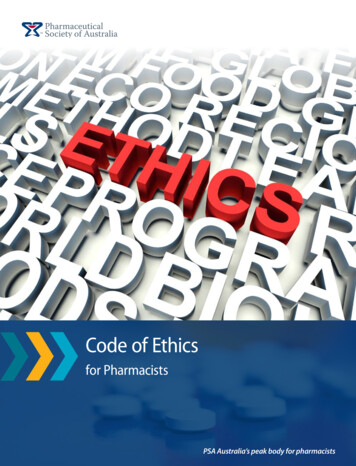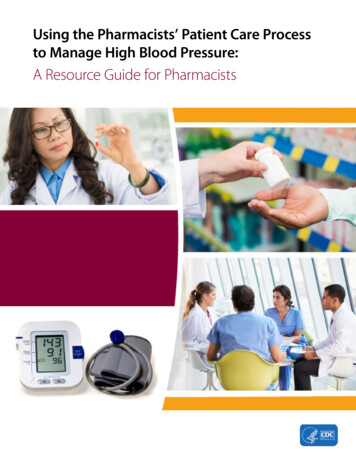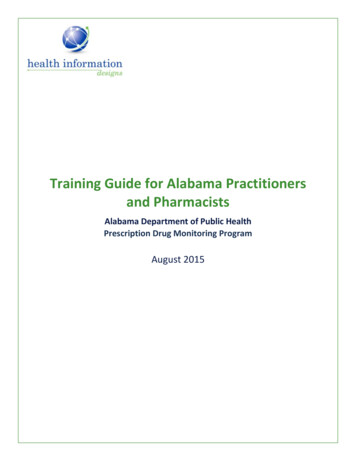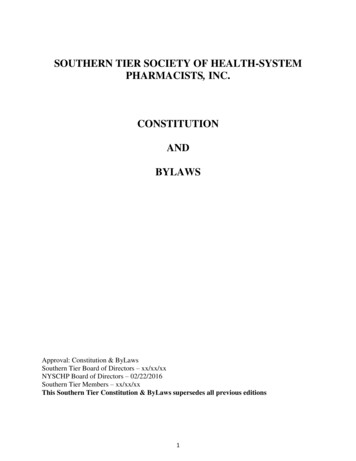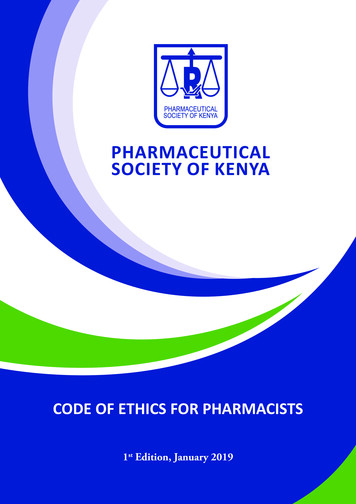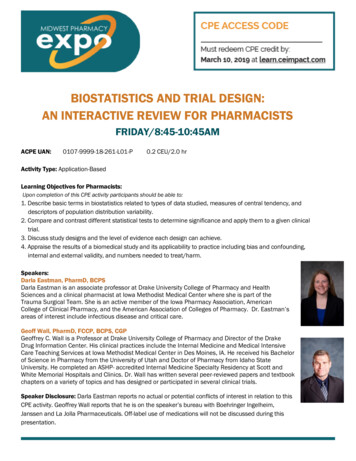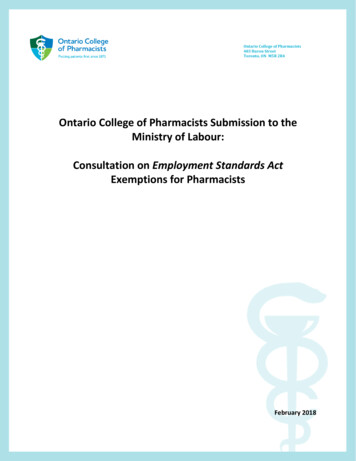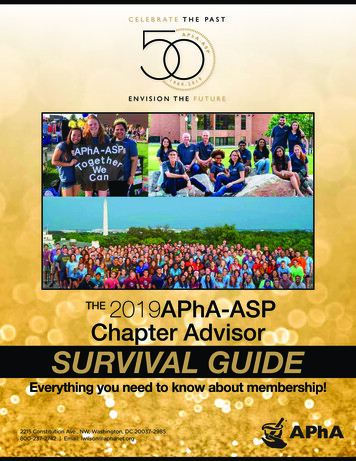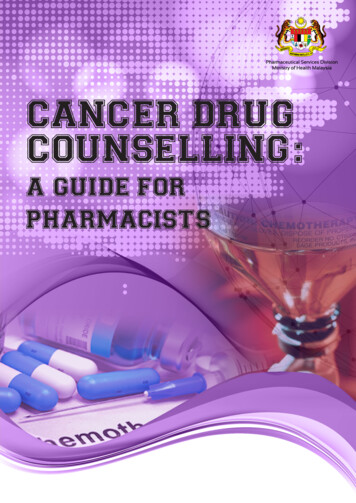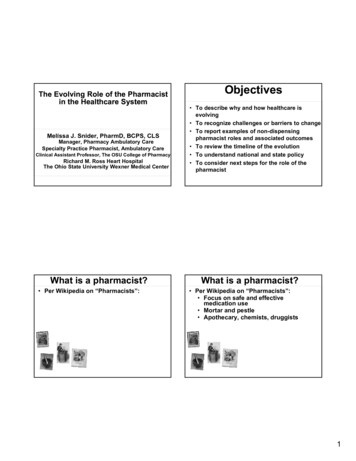
Transcription
The Evolving Role of the Pharmacistin the Healthcare SystemMelissaJ.M liJ Snider,S id PharmD,PhD BCPS,BCPS CLSManager, Pharmacy Ambulatory CareSpecialty Practice Pharmacist, Ambulatory CareClinical Assistant Professor, The OSU College of PharmacyRichard M. Ross Heart HospitalThe Ohio State University Wexner Medical CenterWhat is a pharmacist? Per Wikipedia on “Pharmacists”:Objectives To describe why and how healthcare isevolving To recognize challenges or barriers to change To report examples of non-dispensingpharmacist roles and associated outcomes To review the timeline of the evolution To understand national and state policy To consider next steps for the role of thepharmacistWhat is a pharmacist? Per Wikipedia on “Pharmacists”: Focus on safe and effectivemedication use Mortar and pestle Apothecary, chemists, druggists1
What is a pharmacist? Per Wikipedia on “Pharmacists”: Focus on safe and effectivemedication userole ofthepestlepharmacist has “TheMortarandfrom the chemists,classical ‘lick,stick, shiftedApothecary,druggistsand pour’ dispensary role, to being anintegrated member of the health careteam directly involved in patient care.”Why the evolution? Evolving Health Care Improving quality of life Improving health outcomes Ensuring cost-effectiveness Proper medication use is essential 81% of adults take 1 chronic med 28% of adults 65 yotake 5 chronic meds 30% of children take 1 chronic med 4 billion du/forms/outreach/intro-topharmacy/Evolving Scope of Pharmacy t/files/files/Provider%20Status%20FactSheet Final.pdf.American Journal of Pharmaceutical Education 2010; 74 (10)Article S7Why the evolution? Improper use of medications in US annually Treatment of chronic conditions 1.7 trillion 0.75 of every 1.00 1.5 million preventable med-relatedad erse eadverseeventsents 290 billion in “mostly avoidable” coststo treat inappropriate med use adverseevents Non-adherence results in 100 billion inexcess fault/files/files/Provider%20Status%20FactSheet Final.pdfWhy the evolution? Increasing patient complexity Increased demand Access to providers Manage patients’ medication therapy Identify adverse events Manage drug-relateddrug related problems Vital role in quality prevention Demand for intensive primary care Coordination, management, and integration ofchronic disease care following acute episodesMonolakis, et. al. Am J Pharm Educ. 2010 December 15; 74(10): S7.2
Why the evolution? Physician shortage By 2020, shortage of 91,500 physicians By 2025, shortage to grow to 130,600 Equally distributed among primary care andmedical specialtiesWhy the evolution? Affordable Care Act Signed March 2010 Increased access to insurance Payment structure changing fromvolume to value Creates opportunities for expandingrole for pharmacistsAffordable Care Act (ACA) Affordable care organizations (ACO) &Patient-centered medical homes (PCMH) Optimization of every patient’s medicationtherapy is a core element of our future healthcare system Hospital Collaboration with ambulatory clinics &community pharmacies Provide medication reconciliation Pharmacists in reducing rtunities-hospital-pharmacistsWhy pharmacy? Comprehensive and unique education andtraining Pharmacists as part of Health care team Improved patient outcomes patient satisfaction overall health care costs Interdisciplinary approach evidence Accessibility Strong patient educators and patientcoaches3
Barriers to evolution: 7 P’s Perception/Perspective Personality Preparation Policy Privileging Provider Status PaymentP’s – Perception/Perspective 2009 WV Physician Survey Overall positive attitude toward collaborativepractice Physician more likely to support MTM if Primary Care Fewer years of practice Female Physicians less likely to support MTM frequency of physician-pharmacistcommunication Suspected due to refill/technical based contactAlkhateeb FM. J Am Pharm Assoc (2003). 2009 Nov-Dec;49(6):797-800P’s – Perception/Perspective 2008 Family Physicians on CollaborativePractice Operational & integration challenges recognized Clinical benefits seen Access to reliable drug information Fresh perspectivespp Security in med prescribing 2013 Consumers and PCPs Difficult for most to envision pharmacistspracticing in non-dispensing rolesPottie K, Farrell B, Haydt S, Dolovich L, Sellors C, et al. Integrating pharmacists into familypractice teams. Can Fam Physician. 2008;54:1714-5.e1-5.Smith M. Res Social Adm Pharm. 2013 Sep 19.P’s – Personality 2013 Survey of Hospital Pharmacists in Canada Stronger expression of Extraversion AgreeablenessCi ti Conscientiousness Openness Low levels of Neuroticism Conclusion: Stability in y-relationship-in-organizational-change/Hall J. Can J Hosp Pharm. 2013 Sep;66(5):289-954
P’s – Preparation: Education Per IOM “All health professionals should be educated todeliver patient-centered care as members of aninterdisciplinary team, emphasizing evidencebased practice, quality improvement approaches,and informatics” CAPE Outcomes and ACPE Accreditation Standards Educational competencies of NPs, Pas, andPharmDs Much commonality More therapeutics for pharmacists More diagnostic skills for NPs and PAsP’s – Preparation: Postgraduate Residency Since1930s Practice preparation Competitive jobmarket advantage Networkingopportunities Career planning Professional vision900600300020052012Per Institute of Medicine Committee on the Health Professions Education Summit. HealthProfessions Education: A Bridge to Quality. Greiner AC, Knebel E, eds. Washington, DC:National Academies Press; 2003.P’s – Preparation: Postgraduate Board Certification Traineeships Other certifications “AdvancedPracticePharmacist”P’s – Policy National: Social Security Act State: Collaborative Drug Therapy Management (CDTM) Team approach Practice protocols/guidelines define scope Initiating,g, modifying,y g, and monitoringg drugg therapypy Ordering and performing laboratory & related tests Assessing patient response to therapy Counseling and educating patients Administering medications Local: Institutional policyBrennan et al. http://www.ashp.org/ ntists/ AmbulatoryCarePetition.aspx5
P’s – Privileging Driving forces Specialized role of pharmacistMeasure of competency and accountabilityEfficiencyBilling Collaborative Practice AgreementsMonolakis, et. al. Am J Pharm Educ. 2010 December 15; 74(10): S7.Philip B, Weber RJ. Hosp Pharm. 2013 Feb;48(2):160-5.P’s – Provider Status & Payment Lack of Provider status Limits access to pharmacists’ patient careservicesiandd achievablehibl bbenefitsfit Payment Low reimbursement rate relative to physicianP’s – Privileging Driving forces“Through hospital medical staff actively Specializedrole of pharmacistsupporting pharmacists’privileging, the MeasureofPharmacycompetencyand accountabilitynationalPracticeModelInitiativecan meet itsgoaltoother pprovidersandpayersp ofy integrating pharmacistsEfficiency as effective members of thepatient care team with tangible accountabilityBillingfor achieving optimal drugoutcomes” CollaborativetherapyPracticeAgreementsMonolakis, et. al. Am J Pharm Educ. 2010 December 15; 74(10): S7.Philip B, Weber RJ. Hosp Pharm. 2013 Feb;48(2):160-5.Where are we in the process?Example acogenetic TestingImprovingAdherenceScreeningChronicDisease StatesHome gy andAsthma ClinicFacilitation ofOperation ness ClinicMotivationalInterviewingObesity CareMedicationSafetyTransition ofCarePediatricClinicsGeriatric ClinicsEmergencyDepartmentLipidManagementHeart FailureSubstanceAbuse(prevention,education, andassistance)OsteoporosisImmunizationsProtect YourStentS iSpirometrytServiceAnemia ClinicComprehensiveMedicationReview6
Where are we in the process?Example acogenetic TestingImprovingAdherenceScreeningChronicDisease StatesHome gy andAsthma ClinicFacilitation ofOperation ness ClinicMotivationalInterviewingObesity CareMedicationSafetyTransition ofCarePediatricClinicsGeriatric ClinicsEmergencyDepartmentLipidManagementHeart FailureSubstanceAbuse(prevention,education, andassistance)OsteoporosisImmunizationsProtect YourStentS iSpirometrytServiceAnemia ClinicComprehensiveMedicationReviewMTM: Role and Outcomes Fairview Health Services“The provision ofpharmaceutical care servicesby a licensed pharmacist tooptimize the therapeuticoutcomes of the patient’smedications” Started 1990, standardized 1998, Δ 2006 to MTM:Medication Therapy ManagementMTM: Role and Outcomes Fairview Health Services Started 1990, standardized 1998, Δ 2006 to MTM:Medication Therapy Managementde Oliveira R. J Manag Care Pharm. 2010;16(3):185-95MTM: Role and Outcomes Fairview Health Services“The provision ofpharmaceutical care servicesby a licensed pharmacist tooptimize the therapeuticoutcomes of the patient’smedications” Started 1990, standardized 1998, Δ 2006 to MTM:Medication Therapy Management 10 years of clinical, economic, and humanisticoutcomes related MTM 9068 patient records 33,706 documented encounters (mean 3.7 per pt) 33631 drug therapy problems identified andaddressed 85% of patients had 1 drug therapy problemde Oliveira R. J Manag Care Pharm. 2010;16(3):185-95de Oliveira R. J Manag Care Pharm. 2010;16(3):185-957
MTM: OutcomesMTM: OutcomesClinical Status Assessment 12,851 conditions in4,849 pts not at goal During the course ofMTM services 7,068 (55.0%) improved 2,956 (23.0%) unchanged 2,827 (22.0%) worsenedde Oliveira R. J Manag Care Pharm. 2010;16(3):185-95MTM: Return on Investmentde Oliveira R. J Manag Care Pharm. 2010;16(3):185-95MTM: Return on InvestmentHealth Care Savings 2,913,850 savings total( 86 per encounter)Clinic outpatient visit avoidedSpecialty office visit avoidedEmployee work days savedHealth Care Savings 2,913,850 savings total( 86 per encounter)Laboratory service avoided 2,258,302 2258 302 costst ttotalt l( 67 per encounter)Urgent care visit avoidedEmergency room visit avoidedClinic outpatient visit avoidedSpecialty office visit avoidedEmployee work days savedLaboratory service avoided 2,258,302 2258 302 costst ttotalt l( 67 per encounter)Urgent care visit avoidedEmergency room visit avoidedHospital admission avoidedHospital admission avoidedNursing home admissionsNursing home admissionsHome health visitHome health visit Estimated ROI of 1.29 per 1de Oliveira R. J Manag Care Pharm. 2010;16(3):185-95de Oliveira R. J Manag Care Pharm. 2010;16(3):185-958
MTM outcomesWhere are we in the process? Patient satisfaction 95% of respondents agreed or stronglyagreed that their overall health and wellbeinghad improved because of MTM The healthcare team Each with unique core set of skills & training Services directly impact quality & cost Improved communication and collaboration Conclusion Impact of an MTM program in a largeintegrated health care system suggestimproved clinical, financial, and humanisticoutcomesde Oliveira R. J Manag Care Pharm. 2010;16(3):185-95Where are we in the process? The healthcare team Each with unique core set of skills & training Services directly impact quality & cost Improved communication and collaboration Physicians NonNon-physicianphysician professionalsworking together as teams Patients have improved outcomes Physicians NonNon-physicianphysician professionalsworking together as teams Patients have improved outcomesMonolakis, et. al. Am J Pharm Educ. 2010 December 15; 74(10): S7.Healthcare Team outcomes:Kaiser Permanente Colorado EnvironmentRoles of the Pharmacist Monolakis, et. al. Am J Pharm Educ. 2010 December 15; 74(10): S7.Collaborate with health care teamsMed-related recommendations to prescribersAssist patients in achieving goalsSpecialized pharmacy services ID, mental health, oncology, palliative care, solid organtransplant, CVD, anticoagulationProvide preventive care Immunizations, smoking cessation, MTMDrug informationCost-effective prescribing feedbackGuideline developmentMonolakis, et. al. Am J Pharm Educ. 2010 December 15; 74(10): S7.9
Healthcare Team outcomes:Kaiser Permanente Colorado Environment Anticoagulation Clinical Pharmacy Cardiac Risk Service (CPCRS) Physician-approved guidelines andtelepharmacy Pharmacists provide comprehensiveanticoagulation services Management of excessive anticoagulation Interruption of anticoagulation therapy forinvasive procedures Reduced bleeding complications and adverseevents Manage lipid-lowering & antihypertensivemeds Initiation, dose adjustments, & follow-uplabs Review of 8,014 patients 92% LDL-C levels 130 mg/dL 73% LDL-C levels 100 mg/dL 30% recurrence of CAD complications 9 million cost savings over 6-yearsHelling et al. J Am Pharm Assoc. 2006;46:67-76Monolakis, et. al. Am J Pharm Educ. 2010 December 15; 74(10): S7.Helling et al. J Am Pharm Assoc. 2006;46:67-76Monolakis, et. al. Am J Pharm Educ. 2010 December 15; 74(10): S7.Healthcare Team outcomes:Kaiser Permanente Colorado Environment Clinical Pharmacy International Travel Clinic (CPITC) Advise pts traveling to international destinationsThe Department of Veterans Affairs (VA) Pharmacist role Traditional dispensing Discuss prevention i.e. Traveler’s diarrhea & Mosquito-bornediseases Quality assurance Provide info on vaccines to protect travelers Schedule immunizations 9,500 telephone consultations/yearHelling et al. J Am Pharm Assoc. 2006;46:67-76Monolakis, et. al. Am J Pharm Educ. 2010 December 15; 74(10): S7.Healthcare Team outcomes:Kaiser Permanente Colorado Environment Patient’s health care team Similar to Kaiser Health information technology Manage VA Drug Formulary Additionally, can prescribe under protocol– Anticoag, HTN, HLD, DM, CHF, psychiatry,transplantationImage from CDCMonolakis, et. al. Am J Pharm Educ. 2010 December 15; 74(10): S7.10
VA Outcomes: Economic BenefitSavingsBenefitCostAvoidanceExample For every 1 invested 4 in benefit seen 368,000 savings benefit for each clinicalpharmacist 600 recommendations, 92% were accepted by providersImproved clinical outcomes in 30%Avoided harm in 90%Cost avoidance 700 each; total savings 420,155 2007 Pharmacist-run smoking cessation program 16% quit rate Annual savings 691,200; net cost benefit 551,200Patel RJ et al. Am J Managed Care. 1999; 5:465-74Lee et al. Am J Health-Syst Pharm. 2002; 59:2070-7Monolakis, et. al. Am J Pharm Educ. 2010 December 15; 74(10): S7Osteoporosis: Ukrop’sScreening Outcomes Pt survey of 305 screened 3 to 6 months later Risk of future fracture 37% high 33% moderate 30% low 78% no prior knowledge In the moderate- and high-risk categories 37% scheduled and completed a physician visit 19% had a diagnostic scan 24% were initiated on osteoporosis therapyGoode J et al. J Am Pharm Assoc. 2004; 44; 2:152-60Osteoporosis Ukrop’s Pharmacy and Wellness Centers Setting: Community Grocery-Store Health care screenings, MTM services, Diseasemanagement, Patient education programs Pharmacist Role Highlight: Osteoporosis Perform bone mineral density screening Facilitate identification, education, and referral ofpatients to collaborative community healthmanagement services focused on osteoporosismonitoring and managementGoode J et al. J Am Pharm Assoc. 2004; 44; 2:152-60HTN Management: RCTsCommunity pharmacy-based MTM Pharmacist management of pts w/ DM & HTN % pts at goal blood pressure 20.0% to 6.67% in the control group 16.0% to 48.0% in MTM groupPhysician/pharmacist collaboration Effect on mean BP from baseline to 6-month follow-up by 6.8/4.5 mmHg in control group by 20.7/9.7 mmHg in collaborative care groupde Oliveira R. J Manag Care Pharm. 2010;16(3):185-9511
HTN: Telemonitoring &Pharmacist Management Cluster randomized clinical trial N 450 Usual care (n 222) Telemonitoring and Pharmacist management(n 228) Duration: 12 months intervention & 6 monthsfollow-up Telemonitoring intervention Pt received home BP telemonitors Transmitted data to pharmacists who adjustedantihypertensive therapyMargolis KL, et al. JAMA. 2013;310(1):46-56.HTN: Telemonitoring &Pharmacist ManagementHome BP telemonitoring andpharmacist case managementachieved better BP control compared with usualcareMargolis KL, et al. JAMA. 2013;310(1):46-56Diabetes Pharmacist-supervised Diabetes Treatment Clinic Intervention BG values transmitted via phone or secure message Pharmacists provide med management, frequentfollow-up, and education Results: n 85 in 3 month review Mean HbA1c by 1% No episodes of severe hypoglycemia Conclusion Integration of a pharmacist into a multidisciplinaryPatient-Aligned Care Team in a high-risk diabeticpopulation was successful and is suggested to havea positive impactCollier IA, Baker DM. Am J Health-Syst Pharm. 2014;71:27-36Medicare Annual Wellness Visits Initial Medicare Annual Wellness visit (AWV)administered by clinical pharmacist practitioner (CPP) August 2011 – May 2012 441 interventions during 98 visits 4.5 interventions per AWV 159.3838 per All reimbursable up to a maximum of 159visit Conclusion Medicare AMV administered by a CPP resulted in awide variety of patient interventions andreimbursement for services providedWarshany K et al. Am J Health-Syst Pharm. 2014;71:44-912
PCMHPCMH: Role of Pharmacist isFundamental Patient Centered Medical Home (PCMH) model Coordinated and comprehensive delivery of primary care toall age groups5 Main attributes and functions:Comprehensive Meets demands for mostpt’s primary care needsCoordinated Care can be employedp ywith open communicationPatientCenteredAccessible Enhanced access to careExamplePharmacistRoles Disease State Management Favorable effects known Optimization of medication management AssessingAi medd effectivenessff ti Optimizing costs of drug therapy To improve medication adherence Perform comprehensive med reviewsImproved quality& safety While incorporating EBMNigro SC et al. Pharmacotherapy. 2014;34(1):96-108Evolution of thePharmacist’s RoleNigro SC et al. Pharmacotherapy. 2014;34(1):96-108The Evolving Role of the Pharmacistin the Healthcare SystemTrisha Jordan,Jordan PharmD,PharmD MSAssociate Pharmacy DirectorUniversity HospitalsHealth-System Pharmacy AdministrationResidency CoordinatorThe Ohio State University Wexner Medical Center13
Evolution of the Pharmacist’sRolePharmacist RoleMedication Cost Control Therapeutic medication monitoring Utilization of therapeutic levels Parenteral Nutrition managementg risk medication consult High Anticoagulants Pulmonary hypertension Order set development Technology assessment Emergency ResponsePharmacist RoleMedication Cost ControlPharmacist RoleMedication Assistance High cost targets Identify waste IV bag size conversion IV to PO conversion Commercial to manual preparation Extended dating for IV preparations JIT preparation for high cost medications Attending only ordering Formulary dosage review Formulary non-stock statusCreative Commons Attribution-ShareAlike 3.0 Unported14
Pharmacist Role inMedication AssistanceRole of MedicationAssistance Coordinator Recommend therapeutic/generic alternativesProvide drug informationCorrespond with prescribersCounsel patients Medications Administration technique (i.e. enoxaparin) Keep current on Medicare and Medicaid coveragepolicies Facilitate reimbursement for off-label indications Literature research and support AppealsPharmacist Role inCore Measures 44 core measures 22 (50%) medication related Act as a resource to promote compliance Ensure documentation Pharmacist provide documentation Analysis of charts with missingdocumentation Pharmacists prevented failure 96% cases Ensure all eligible patients receive necessarymedications as soon as clinically possible Screen for assistance Coordinate benefits Enroll patients into programs Manufacturer assistance programsDisease-based assistance programsMedicare Part D prescription drug benefitsSocial SecurityLow income subsidy Provide co-pay assistance for underinsured Provide vouchers for use of charity fundsRole in the Emergency Department Pharmacist role Medication Storage Medication order intervention& adjustment Medication history Question resolution Emergency response Evolving role Antimicrobial stewardshipCreative CommonsAttribution-ShareAlike 3.0UnportedOlipharnt, CS J Pharm Pract. 2013 Dec 1015
Antimicrobial Stewardship Optimize use ofantimicrobials Positive outcomesin the inpatientsetting EmergencyDepartment (ED)patients notincluded in mostprogramsED Pharmacist-ManagedAntimicrobial Stewardship 47-bed, level 3 trauma center 80,000 visits annually Retrospective evaluation of medical records ED physicianh i i vs. pharmacisthi t managedd cultureltreview Primary outcomes: Frequency of antimicrobial modifications Occurrence of ED readmission within 96 hoursMay L. Ann Emerg Med. 2012; Nov 2.Dellit T, et. al. Clin Infect Dis: 2007; 44:159-177.Randolph. Am J Health-Syst Pharm. 2011; 68:916-919.ED Pharmacist-ManagedAntimicrobial er ofculture reports22782361Number ofantimicrobialmodifications12% (275/2278)15% (355/2361)Rate ofreadmissionwithin 96 hours19% (432/2278)7% (165/2361)*Pharmacist Role inMedication Reconciliation*p .001Randolph. Am J Health-Syst Pharm. 2011; 68:916-919.Creative Commons Attribution-ShareAlike 3.0 Unported16
Pharmacist Role inMedication Reconciliation National Patient Safety Goal 2006 Significant challenges to implementation Patient: cognitive Healthcare: time and personnel Best strategy is still unclear Incorporating pharmacist improvedaccuracyTransitions of Care New codes beginning in January 2013 Developed to address non face-to-face workrequired to coordinate services during caretransitions 99495 Moderate complexity patient 99496 High complexity patient Cost and time prohibitive Target approach using alternative staffTransitional CareCoordination Contact with patient/caregiver within 2 businessdays of discharge Face-to-face, telephonic, electronic Emphasis on medication reconciliation, activitiesof daily living,living patient education,education services neededby patient/familyTransitional CareCoordination WorkflowPatient discharged Discharge summary sent to PCPPhysician review to determine complexity Message sent to pharmacy to contact patientPharmacist contacts within 2 business days Face-to-face visit with physician within 7 or 14 days Continued coordination for 30 days post-discharge Assess patient; medication reconciliation; confirmappointments; document and send to PCPPatient scheduled for PCP appointment 7 or 14 days Review pharmacy note; focus on fm?printPage 1&17
Transitions of Care 3 rural Wisconsin pharmacies performingmedication reconciliation post-discharge Pharmacist schedule one-on-onecounseling with patients N 60 At least 1 medication discrepancy duringtransitions of care for 95% patients New medication started Dosing changes Medication stoppedFreund JE, et. al. Innovations. 2013; 4(2):117Transitions of Care University of Kansas October 2012: Pharmacy practice model with HFemphasis Pharmacy medication reconciliation atadmission and discharge IntensiveI ti dischargedi hcounselingli Pharmacist: Patient – 1:30 (non-ICU) Pharmacist in HF clinic 30-day readmission rate dropped from 22.6% to14.7% Targeting HF, MI, pneumonia, and COPD /NewsArticle.aspx?id 3860Evolution of Pharmacy PracticeEvolution of Pharmacy Practice Collaborative Drug Therapy Management (CDTM) Agreement between a physician & VeteransAffairs2000NorthCarolina2013California Defined scope of practice Settings Indian Health Services Consultation rooms Monitoring protocols Pharmacy practitioner training program New Mexico Pharmacist Prescriptive Authority Act Meet identified needMonolakis, et. al. Am J Pharm Educ. 2010 December 15; 74(10): S7.18
Evolution of Pharmacy arolina2013California1960IndianHealthServiceNorth CarolinaVeterans Affairs Medical Centers Veterans Affairs Medical Centers Clinical Pharmacist Specialists (CPSs) Mid-level providers similar to NP/PAs Protocols allow for: Initiation, modification and discontinuationof medications Order and review lab tests Administer medications Provide preventative services Perform limited physical examsEvolution of Pharmacy Practice Pharmacists with additional licensure can providehigher level of care for patients Prescriptive authority, can apply for DEA Only North Carolina’s FORM program is solelypharmacy based, with pharmacy providers receivinga professional service fee per patient per quarter 3rd parties manage MTM programs Accepts patients taking more than 11 medicationseach month Obtaining reimbursement for their non-dispensingservices is a e L. ASHP 20081-8;.19
California SB 493 California SB 493 – Scope of PracticeSeries of 4 laws to address provider shortagePharmacist as providersExpansion of Medi-Cal programAdvanced Practice PharmacistRequires Certification Post graduate residency training Year experience with sNationally Administer drugs and biologics when ordered by aprescriber Order and interpret tests for the purpose ofmonitoring and managing the efficacy and toxicity Consult, train, and provide education about drugththerapyandd diseasedipreventiontiandd managementt Provide travel recommendations per the CDC Provisions that may be approved later this year: Initiate, adjust, and discontinue drug therapypursuant to an order by a patient’s treating prescriberand in accordance with established -billsCredentialing and Privileging TJC Social Security Act Definition of a healthcare provider MD, NP, RD, OD, social worker Provider Reimbursement May 16, 2012 CMS published a rule expanding thed fi iti off medicaldefinitiondi l stafft ff Pharmacists included Allows non-physician providers to haveprivileges Can request formal privileges Extent of privileges are based on training andscope of practicedYap, Diana. CMS Expands Hospital Medical Staff Conceptto Include Nonphysicians. APhA. June 6, 2013. Allows for non-physician providers to beappointed Privileges must be within scope defined bylaw Once granted practitioner is bound bybylaws Historically Pharmacists have not participated Practice determined by state law1) Blair M, et. al. Am J Health-Syst Pharm. 2007;64:2372-812) Galt,K. Am J Health-Syst Pharm. 2004;61:661-7020
Ohio Law – ORC:4729-39Ohio Law – ORC:4729-39 Institutional consult agreement Ambulatory consult agreement Separate agreement for each individual for aspecific diagnosis Agreement must be in writing AgreementbetweenMD, RPh andAtbtMDd patientti t Before making any changes the pharmacistmust attempt to contact and confer with the MD Pharmacist must send a written report of allactions taken Consult may be terminated at any timeOhio Law – OAC:4729-29 Institutional policy for consult agreementmust include Appropriate credentialing process for eachpharmacist Policy must be in place Agreement must be in writing and consistentwith hospital’s policy on consult agreements Agreement must be communicated to thepatient Actions must be documented in the medicalrecord Communications between the pharmacist andphysician must take place Consult may be terminated by any party at anytimeCurrent Ohio Legislation – SB 240 ORC: 4729-01 Consult agreement would be expanded toone or more physician ORC: 4729-39 Would allow pharmacists to: Delineation of pharmacist scope of practicevia privileges Quality assurance mechanism Manage individual drug therapy Order blood tests Eliminate burdensome paperwork Eliminate need for consult policies ininstitutional settings21
Legislation in Ohio towardExpanding RolesPayer Recognition of Pharmacists State Medicaid programs recognizepharmacists as providers SB 79: Immunization expansion: Allowingpharmacists and pharmacy interns toadminister all CDC-recommended vaccinesto patients who are seven years or older 9 states are experimenting (including Ohio) Provide MTM services to select patients Goal to improve outcomes and lower cost Rabies vaccine Share key characteristics HB 44: Pharmacists and pharmacy internscould dispense limited quantities of drugswithout a written, oral or electronicprescription during a declared public healthemergency. Pharmacist based CPT billing Most created with College of PharmacyfacultyDaigle L. ASHP 2
6 P's - Privileging Driving forces Specialized role of pharmacist Measure of competency and accountability Efficiency Billing Collaborative Practice Agreements Monolakis, et. al. Am J Pharm Educ. 2010 December 15; 74(10): S7. Philip B, Weber RJ. Hosp Pharm. 2013 Feb;48(2):160-5. P's - Privileging Driving forces Specialized role of pharmacist
